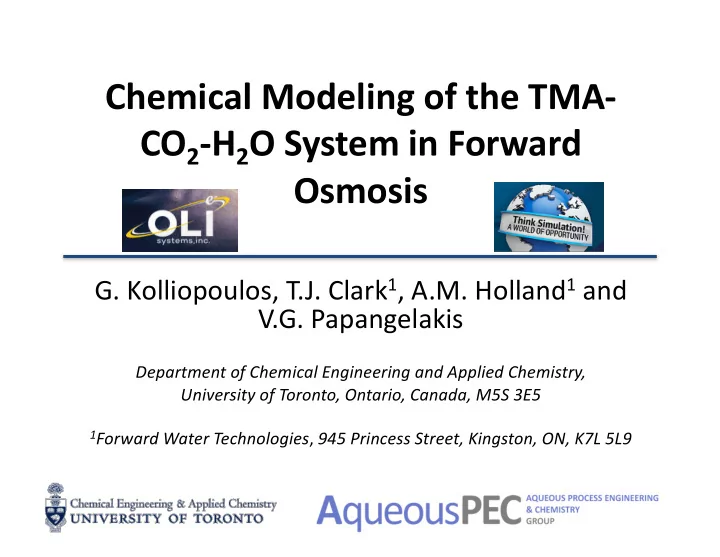

Chemical Modeling of the TMA- CO 2 -H 2 O System in Forward Osmosis G. Kolliopoulos, T.J. Clark 1 , A.M. Holland 1 and V.G. Papangelakis Department of Chemical Engineering and Applied Chemistry, University of Toronto, Ontario, Canada, M5S 3E5 1 Forward Water Technologies , 945 Princess Street, Kingston, ON, K7L 5L9
Forward Osmosis (FO) Difference in H 2 O activity: the driving force of the process No application of hydraulic pressure Advantages of FO: Challenges of FO: High H 2 O recovery (>90%) [1] • FO-specific membranes • Energy savings based on equivalent work: • Ideal draw solute: • 72-85% comparing with Reverse Osmosis Highly soluble (RO), Evaporation-Condensation [2] – Easily separated from the DDS – Lower membrane fouling (vs. RO) • Recoverable products upon separation – [1] T.Y. Cath et al., J. Membr. Sci. 281 (2006), pp. 70–87 [2] R.L. McGinnis, M. Elimelech, Desalination 207 (2007), pp. 370-382 1
Conceptual FO Process Flow Diagram 2
FO Process Treatment Window
Draw Solution Thermolytic salts exhibit phase change upon heating: NH 3 -CO 2 (well studied) • – formation of carbamates (stable in solution-difficult to separate) Trimethylamine (TMA)-CO 2 (newly proposed) • – no formation of carbamates (easier separation) – higher water flux CO 2 N Concentration Osmotic Pressure Concentration (molal) (atm) (molal) Carbonated NH 3 3.53 3.53 88.5 Carbonated TMA 3.53 3.53 104.8 Carbonated NH 3 13.84 7.5 366.1 Carbonated TMA 13.84 13.5 371.7
Objective Develop an accurate mathematical model describing the various equilibria in the ternary system TMA-CO 2 -H 2 O in order to design an integrated FO process: a) Develop analytical techniques for the determination of total dissolved TMA and CO 2 at high concentrations b) Verify the properties binary TMA-H 2 O system (well studied since the 1930s) - ionization constant and its vapour-liquid equilibria (VLE) c) Generate thermodynamic data for the ternary system TMA-CO 2 -H 2 O that can be incorporated in chemical chemical modeling software, such as OLI (www.olisystems.com) 5
a) Analytical Techniques for total dissolved TMA and CO 2
b) Binary TMA-H 2 O System
Binary TMA-H 2 O System - Ionization Constant Known mass (20 g) of 2 M HCl was titrated with aqueous TMA at 25 °C: 2.14% Error OLI-MSE 8
Binary TMA-H 2 O System - VLE [6] S.D. White, B.K. O'Neill, Journal of Chemical & Engineering Data, 38 (1993) 234-237. 9
VLE (20 °C) Liquid Samples Water content measured by • Karl-Fischer titration Vapor Samples Mole fraction of H 2 O in the • vapor phase determined on the basis of i) molecular weight of TMA and H 2 O, ii) measured mass of vapor phase, and iii) ideal-gas law 10
Binary TMA-H 2 O System - VLE (20 °C) 11
c) Ternary TMA-CO 2 -H 2 O System
pH-Composition Experiments (4 and 25 °C) C TMA =42 wt.% in H 2 O Inject CO 2 (g) (P=5 bar) for 60 min Sample every 10 min TMA (aq) +CO 2(g) +H 2 O = TMAH + +HCO 3- 13
VLE (50 and 60 °C) Liquid Samples Water content measured by Karl- • Fischer titration and GC (Agilent Technologies 7890A with thermal conductivity detector - Capillary column: CPVolamine 30x0.32, Agilent Technologies CP7447) Vapor Samples GC: • i. Injection of He into the vapor flask (room T); contents at 100 kPa absolute pressure ii. Sealed flask placed in controlled hot-air chamber; contents to at least 10 °C higher than T at which sample was collected à contents vaporized completely prior to withdrawing sample 14
Experimental Results vs. OLI-MSE 4 °C 25 °C TMA Evaporation 15
Regressed OLI-MSE Model 4 °C 25 °C 16
Evaluation of Developed Model pH and composition experimental measurements (25 °C) in solutions that were not used to fit the model: 17
Conclusions • Speciated VLE for TMA-H 2 O are consistent with literature data (embedded in OLI-MSE model) • Significantly low accuracy of the default OLI-MSE model for TMA-CO 2 -H 2 O, as a result of missing binary interaction parameters • Existing databank for TMA-CO 2 -H 2 O was improved by incorporating these parameters between the dominant species, i.e., TMAH + and HCO 3- ,as well as TMA and HCO 3- • Developed OLI-MSE model is able to predict the properties of TMA-CO 2 -H 2 O with Absolute Average Relative Deviation (AARD) of 8, 15, 10 and 1% for total pressure, partial pressures of TMA and CO 2 as well as pH, respectively 18
Acknowledgements 19
Recommend
More recommend